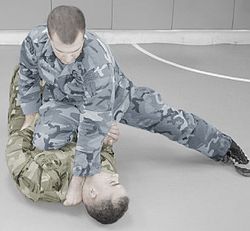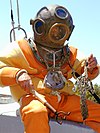Asphyxia
| Asphyxia | |
|---|---|
| Specialty | Emergency medicine |
Asphyxia or asphyxiation is a condition of severely deficient supply of oxygen to the body that arises from abnormal breathing. An example of asphyxia is choking. Asphyxia causes generalized hypoxia, which affects primarily the tissues and organs. There are many circumstances that can induce asphyxia, all of which are characterized by an inability of an individual to acquire sufficient oxygen through breathing for an extended period of time. Asphyxia can cause coma or death.
In 2013 about 1.6 million cases of unintentional suffocation occurred.[1] The word asphyxia is from Ancient Greek α- "without" and σφύξις [sphyxis] Error: {{Lang}}: text has italic markup (help), "squeeze" (throb of heart).[2]
Cause
Situations that can cause asphyxia include but are not limited to: the constriction or obstruction of airways, such as from asthma, laryngospasm, or simple blockage from the presence of foreign materials; from being in environments where oxygen is not readily accessible: such as underwater, in a low oxygen atmosphere, or in a vacuum; environments where sufficiently oxygenated air is present, but cannot be adequately breathed because of air contamination such as excessive smoke.
Other causes of oxygen deficiency include but are not limited to:
- Acute respiratory distress syndrome
- Carbon monoxide inhalation, such as that from a car exhaust and the smoke's emission from a lighted cigarette: carbon monoxide has a higher affinity than oxygen to the hemoglobin in the blood's red blood corpuscles, bonding with it tenaciously, and, in the process, displacing oxygen and preventing the blood from transporting oxygen around the body
- Contact with certain chemicals, including pulmonary agents (such as phosgene) and blood agents (such as hydrogen cyanide)
- Drowning
- Drug overdose
- Exposure to extreme low pressure or vacuum to the pattern (see space exposure)
- Hanging, specifically suspension or short drop hanging.
- Self-induced hypocapnia by hyperventilation, as in shallow water or deep water blackout and the choking game
- Inert gas asphyxiation
- Ondine's curse, central alveolar hypoventilation syndrome, or primary alveolar hypoventilation, a disorder of the autonomic nervous system in which a patient must consciously breathe; although it is often said that persons with this disease will die if they fall asleep, this is not usually the case
- Respiratory diseases
- Sleep apnea
- A seizure which stops breathing activity
- Strangling
- Breaking the wind pipe .
Smothering
Smothering is the mechanical obstruction of the flow of air from the environment into the mouth and/or nostrils, for instance, by covering the mouth and nose with a hand, pillow, or a plastic bag.[3] Smothering can be either partial or complete, where partial indicates that the person being smothered is able to inhale some air, although less than required. In a normal situation, smothering requires at least partial obstruction of both the nasal cavities and the mouth to lead to asphyxia. Smothering with the hands or chest is used in some combat sports to distract the opponent, and create openings for transitions, as the opponent is forced to react to the smothering.
In some cases, when performing certain routines, smothering is combined with simultaneous compressive asphyxia. One example is overlay, in which an adult accidentally rolls over onto an infant during co-sleeping, an accident that often goes unnoticed and is mistakenly thought to be sudden infant death syndrome.[3] Other accidents involving a similar mechanism are cave-ins or when an individual is buried in sand or grain.
In homicidal cases, the term burking is often ascribed to a killing method that involves simultaneous smothering and compression of the torso.[4] The term "burking" comes from the method William Burke and William Hare used to kill their victims during the West Port murders. They killed the usually intoxicated victims by sitting on their chests and suffocating them by putting a hand over their nose and mouth, while using the other hand to push the victim's jaw up. The corpses had no visible injuries, and were supplied to medical schools for money.[5]
Compressive asphyxia

Compressive asphyxia (also called chest compression) is mechanically limiting expansion of the lungs by compressing the torso, hence interfering with breathing. Compressive asphyxia occurs when the chest or abdomen is compressed posteriorly.[6] In accidents, the term traumatic asphyxia or crush asphyxia usually refers to compressive asphyxia resulting from being crushed or pinned under a large weight or force. An example of traumatic asphyxia includes cases where an individual has been using a car-jack to repair a car from below, and is crushed under the weight of the vehicle.[4] Pythons, anacondas, and other constrictor snakes kill through compressive asphyxia. In cases of co-sleeping ("overlay"), the weight of an adult or large child may compress an infant's chest, preventing proper expansion of the chest. Risk factors include large or obese adults, parental fatigue or impairment (sedation by drugs or alcohol) of the co-sleeping adult and a small shared sleeping space (for example, both adult and infant sharing a couch).
In fatal crowd disasters, compressive asphyxia from being crushed against the crowd causes the large part of the deaths, rather than blunt trauma from trampling. This is what occurred at the Ibrox disaster in 1971, where 66 Rangers fans died; the 1979 The Who concert disaster where 11 died; the Luzhniki disaster in 1982, when 66 FC Spartak Moscow fans died; and at the Hillsborough disaster in 1989, when 96 Liverpool fans were crushed to death in an overcrowded terrace. In confined spaces, people push and lean against each other; evidence from bent steel railings in several fatal crowd accidents have shown horizontal forces over 4500 N (equivalent to a weight of approximately 450 kg, or 1014 lbs). In cases where people have stacked up on each other forming a human pile, estimations have been made of around 380 kg (838 lbs) of compressive weight in the lowest layer.[7]
"Positional" or "restraint" asphyxia is when a person is restrained and left alone prone, such as in a police vehicle, and is unable to reposition himself or herself in order to breathe. The death can be in the vehicle, or following loss of consciousness to be followed by death while in a coma, having presented with anoxic brain damage. The asphyxia can be caused by facial compression, neck compression, or chest compression. This occurs mostly during restraint and handcuffing situations by law enforcement, including psychiatric incidents. The weight of the restraint(s) doing the compression may contribute to what is attributed to positional asphyxia. Therefore, passive deaths following custody restraint that are presumed to be the result of positional asphyxia may actually be examples of asphyxia occurring during the restraint process.
Chest compression is also featured in various grappling combat sports, where it is sometimes called wringing. Such techniques are used either to tire the opponent or as complementary or distractive moves in combination with pinning holds,[8] or sometimes even as submission holds. Examples of chest compression include the knee-on-stomach position; or techniques such as leg scissors (also referred to as body scissors and in budō referred to as do-jime;[9] 胴絞, "trunk strangle" or "body triangle")[10] where a participant wraps his or her legs around the opponent's midsection and squeezes them together.[11]
Pressing is a form of torture or execution that works through asphyxia e.g.Burking.
Perinatal asphyxia
Perinatal asphyxia is the medical condition resulting from deprivation of oxygen (hypoxia) to a newborn infant long enough to cause apparent harm. It results most commonly from a drop in maternal blood pressure or interference during delivery with blood flow to the infant's brain. This can occur as a result of inadequate circulation or perfusion, impaired respiratory effort, or inadequate ventilation.[12] There has long been a scientific debate over whether newborn infants with asphyxia should be resuscitated with 100% oxygen or normal air.[12] It has been demonstrated that high concentrations of oxygen lead to generation of oxygen free radicals, which have a role in reperfusion injury after asphyxia.[13] Research by Ola Didrik Saugstad and others led to new international guidelines on newborn resuscitation in 2010, recommending the use of normal air instead of 100% oxygen.[14][15]
See also
References
- ^ Global Burden of Disease Study 2013, Collaborators (22 August 2015). "Global, regional, and national incidence, prevalence, and years lived with disability for 301 acute and chronic diseases and injuries in 188 countries, 1990-2013: a systematic analysis for the Global Burden of Disease Study 2013". Lancet (London, England). 386 (9995): 743–800. PMID 26063472.
{{cite journal}}:|first1=has generic name (help)CS1 maint: numeric names: authors list (link) - ^ "Asphyxia Origin". Online Etymology Dictionary. Retrieved 19 July 2015.
- ^ a b Ferris, J.A.J. "Asphyxia" (DOC). pathology.ubc.ca. Retrieved March 1, 2006.
- ^ a b DiMaio, Vincent; DiMaio, Dominick (2001). Forensic Pathology, Second Edition. Selected Pages from CHAPTER 8 and from Deaths Occurring Following the Application of Choke or Carotid Holds. www.charlydmiller.com. URL last accessed March 2, 2006.
- ^ "Burking Law & Legal Definition". definitions.uslegal.com. Retrieved 2015-08-07.
- ^ Jones, Richard. Strangulation. www.forensicmed.co.uk. URL last accessed February 26, 2006.
- ^ Fruin, John. "The Causes and Prevention of Crowd Disasters". crowddynamics.com. Retrieved March 3, 2006.
- ^ Ohlenkamp, Neil Principles of Judo Choking Techniques. judoinfo.com. URL last accessed on March 3, 2006
- ^ Do-jime is a prohibited technique in Judo, (The Kodokan Judo Institute. Kodokan.Org classification of techniques. www.kodokan.org. URL last accessed March 4, 2006.) and is considered a 'slight infringement' according to IJF rules, Section 27: Prohibited acts and penalties, article 21. It should not be confused with do-osae, which is a colloquial term for the guard position.
- ^ International Judo Federation. IJF Referee Rules. www.ijf.org. URL last accessed March 6, 2006
- ^ Lewis, Bill. Katsuhiko Kashiwazaki – Shimewaza (Book Review). www.bjj.org. URL last accessed March 4, 2006.
- ^ a b Davis, PG; Tan, A; O'Donnell, CPF; Schulze, A (2004). "Resuscitation of newborn infants with 100% oxygen or air: a systematic review and meta-analysis". The Lancet. 364: 1329–1333. doi:10.1016/S0140-6736(04)17189-4. PMID 15474135.
- ^ Kutzsche, S; Ilves, P; Kirkeby, OJ; Saugstad, OD (2001). "Hydrogen peroxide production in leukocytes during cerebral hypoxia and reoxygenation with 100% or 21% oxygen in newborn piglets". Pediatric Research. 49: 834–842. doi:10.1203/00006450-200106000-00020. PMID 11385146.
- ^ ILCOR Neonatal resuscitation Guidelines 2010
- ^ Norwegian paediatrician honoured by University of Athens, Norway.gr
Further reading
- Sir James Kay-Shuttleworth (1834). The Physiology, Pathology, and Treatment of Asphyxia. Longman, Rees, Orme, Brown, Green & Longman.
- Elsner R (September 1989). "Perspectives in diving and asphyxia". Undersea Biomed Res. 16 (5): 339–44. PMID 2678664.

